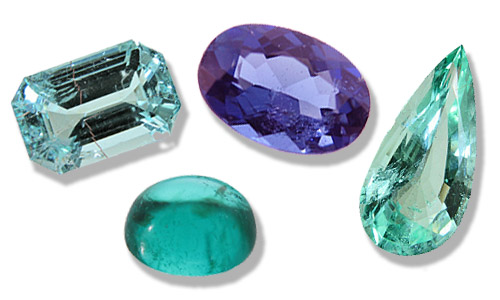Paraïba reloaded
The debate about correct nomenclature, which was sparked by the discovery of a new tourmaline deposit in Moçambique, seems to have come to an end. Traders, gemmologists and appraisers the world over have agreed to call all copper-bearing elbaïtes Paraïba Tourmalines, regardless of their actual origin.

The history of the debate
In 1989 exceptionally vivid tourmalines were discovered in the brazilian federal state of Paraïba. From a mineralogical viewpoint they belonged to the tourmaline species of elbaїte albeit (pardon the pun) with a copper content of up to 2.3% which is responsible for the exciting colours of these gems.
Thereupon CIBJO, the World Jewellery Confederation defined Paraïba Tourmalines as green to blue cupriferous (copper-bearing) tourmalines without adressing the issue of origin, which, admittedly, was not an issue at that time.
Discussions started with the discovery of tourmalines in Nigeria which are not nearly as attractive as the brazilian stones and are easily identifiable by their content of lead. The thing is they do also contain copper and thus are marketed by some as Paraïba Tourmalines up to this day – law- if not rightfully so according to the current state of affairs.
In the autumn of 2005 a tourmaline deposit was eventually discovered in Moçambique, the best stones of which can compete with the original Paraïba Tourmalines from Brazil.
After heated debates as to whether the term "Paraïba" should be confined to the brazilian stones or whether all cupriferous tourmalines could (and should) be referred to as such, regardless of origin, an agreement seems to have been found.
Influential bodies like CIBJO, LMHC (Laboratoy Manual Harmonization Committee), GIA (Gemological Institue of America) and AGTA (American Gem Traders Association) have agreed to refer to all cupriferous elbaїte tourmalines as " Paraïba Tourmalines".
In their certificates the gemmological laboratories of the world do treat the issue somewhat differentially.
The species is always stated as " Elbaïte Tourmaline". The variety is specified by Gübelin as "Paraïba", by AGTA as "blue" or "green" tourmaline. SSEF (Swiss Gemmologial Association) and GIA do not specify variety at all.
Origin is not always specified. All labs, however, do point out in commentaries that these gems are called "Paraïba" by the trade and that they do not necessarily originate from the state of Paraïba in Brazil.
Interestingly enough the autumn 2007 issue of GIA´s quarterly journal "Gems & Gemology" reports the discovery of two new elbaїte (or Paraïba) tourmaline mines in Brazil. Both the "Glorious Mine" and the "Mineraçao Batalha Mine" are located just a few miles from the site of the original deposit, the "Mina de Batalha".
Unfortunately so far only the Glorious Mine produces facettable gem quality. Quantity and size, as well, leave much to be desired. At the time of writing only about 100pcs with an average weight of only about 0.20cts had been cut. Colours, however, are just as exciting as those of the original find.
We wish the japanese operators of the Glorious Mine all the luck and hope that productivity and size will rise dramatically and that prices for these truly amazing gems will fall to more accessible levels soon.
 Deutsch
Deutsch